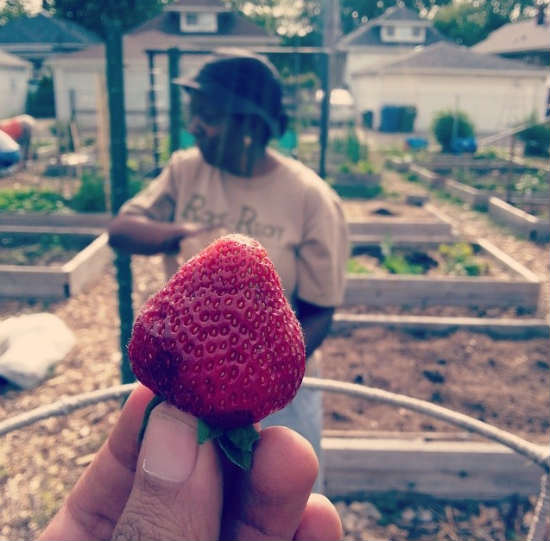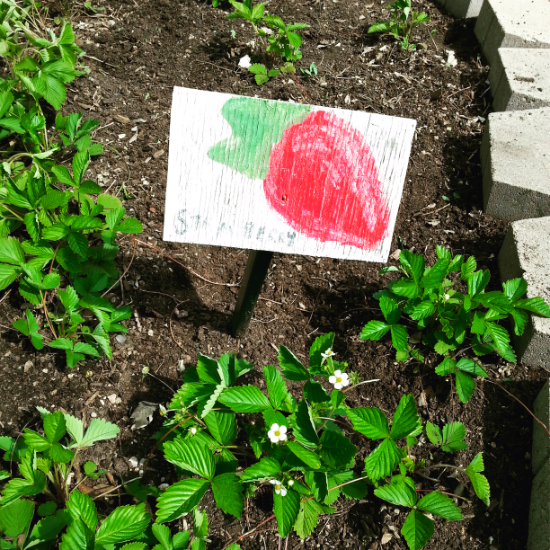Like tomatoes, growing strawberries is one of garden’s simple pleasures. It doesn’t really get any better than biting into a ripe strawberry grown right in your backyard or community garden plot. Don’t believe me? Read these tips on growing strawberries and make plans to plant your own patch in the garden next year, or learn to prepare your patch for next year.

Strawberry varieties
Generally speaking, there are two varieties of strawberries that you can grow: “everbearers” and “short-day strawberries. Short-day strawberry varieties produce fruit when the days are shorter than the nights, like you find in fall and through early spring. Everbearer strawberry varieties are not affected by the length of the day and are referred to as “day neutral.” These strawberries produce year-round with the majority of their fruit being produced in early spring through October.
Planting strawberries
Strawberries require soil that has been well-prepared for their planting by adding compost and fertilizer according to application guidelines. Special garden beds and raised beds are ideal areas for planting strawberries. Make sure that the spot you want to plant has not had any plants in the Solanaceae (eggplants, tomatoes, peppers) family growing in that area for about 2-3 years. The best time to initially plant a strawberry patch is in the early spring for the short day varieties. This time of year is when you can order strawberry plants from catalogs, or buy them bare root at garden centers. Day neutral strawberries should also be planted at this time if they are available. After they have finished producing, you can transplant older plants and runner into new beds to give them a chance to get settled in for the winter.
After amending the soil, lay down your drip irrigation, cover the soil and drip system with a weed barrier like landscaping fabric. Cut an X into the weed barrier and plant your strawberry starts through the opening. Plant your strawberry plants 8″ to 14″ apart in single rows that are 5″ to 6″ high and 6″ to 12″ like the professionals do it. The weed barrier, drip irrigation and spacing of plants will ensure an abundant crop of strawberries with minimal damage from drying out, slugs, pill bugs, earwigs and snails that munch on ripening berries. If you use organic mulches, be aware that many bugs will thrive in that mulch and will probably attack your berry crop.
Growing strawberries in containers
If the above seems like too much work, you can certainly choose to grow strawberries in containers and hanging baskets. Narrow window boxes are also suitable for growing strawberries and some people have great success making strawberry planters from PVC pipes. As long as you provide them with full sun and don’t let the plants sit in soggy soil, you should be rewarded with luscious strawberry plants in 3 months.

Strawberry growing troubles
Pests are a part of garden life, but especially when you are growing something as delicious as strawberries. Using a weed barrier between your plants and soil will minimize how many creepy crawlies can reach your plants and berries. The barrier also helps keep the berries from touching moist soil that could lead to your fruit rotting. If you don’t plant strawberries as recommended above, you could end up with sparse berry patches like in the picture above.
Birds and squirrels are a big problem for strawberry lovers. You can either take the berry theft in stride, or create a barrier using netting or chicken wire to keep the larger pests out of your berry patch.
Strawberry growth and flavor is affected by day length, sun and temperatures. Warm temperatures and long days produce more leaves and runner on your plants. While short-day varieties need cool, short days in order to set flowers for fruit production. You’ll get the most flavorful strawberries when the days are warm and sunny and the nights are cool
Possibly the biggest mistake you could make when planting strawberries is to plant the crown too deep. You can prune off the runners that are produced the first year to allow the plant to focus on setting flowers and fruit. In subsequent years, if your plant’s growth loses vigor, it may be time to replace the plants with new ones. But before that, you can try to revive the soil by amending it very heavily.
There is nothing quite as rewarding as growing strawberries that melt-in-your-mouth. Store bought fruit just doesn’t compare.

Share tips, start a discussion or ask one of our experts or other students a question.
No Responses to “A Foolproof Guide to Growing the Most Delicious Strawberries”